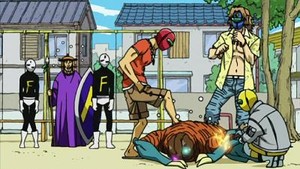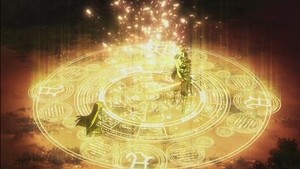The Fall 2009 Anime Preview Guide
Theron Martin
by Theron Martin,
Fairy Tail

Rating: 3 (of 5)
Review: What would you expect from an anime using such a highly-interpretable title as Fairy Tail? Something gleefully irreverent, full of the same kind of high spirits seen in Gurren Lagann or One Piece and loaded with magic, and that's exactly what we get. Yeah, the animation sucks balls; yeah, the character designs and overall artistic style, despite supposedly being toned down from the manga, parrots One Piece a little too much; yeah, the first episode is awash in common anime clichés. It is still a fun and energetic show, though, and that is enough to sell the first episode.
In the fantasy land of Fiore, magic use is common and wizards generally do their business as part of Guilds. The Guild that Lucy, a Celestial Wizard (which means she uses keys to summon spirits to do her bidding, albeit ones that sometimes have a lot of ‘tude), dreams of joining is Fairy Tail, a Guild famous (some might say “notorious”) for its might and destructive power. Instead she encounters a literal charmer who claims to be the Fairy Tail wizard Salamander and Natsu, a young man with horrendous motion sickness issues who travels with the cat-like Happy and just happens to turn out to be the real Salamander. Much mayhem ensues, and Lucy gets an invite to join the Guild for her part in it.
Okay, so this one isn't going to be a paragon of quality control or originality, but as long as it maintains its high spirits and fun factor it is at least watchable.
Nogizaka Haruka no Himitsu 2 – Purezza - episode 2

Rating: 3.5 (of 5)
Review: With its second episode this series prominently features both of the faces that it nurtured through its first series. One is its randy face, the product of its delight in setting up situations where eavesdroppers think that Haruka and Yuto are engaged in some manner of explicit sexual activity (in this case, Yuto deflowering Haruka using a condom) only to discover that they are, in actuality, doing something perfectly innocent but just using easily misinterpretable choices of words. The second it is charming face, the result of select scenes which hit such a perfect mix of sweetness and sentimentality that their appeal is irresistible. This is a series well-capable of making even cynical souls like it even as they acknowledge the retread otakucentric content and average technical merits.
This time around Haruka has decided to get involved with doujinshi and Yuto, who is asked to help with sales for a doujinshi circle at a local convention, gets sucked in, too. Most of the episode is about Haruka first making a doujinshi about Nocturne Girl's School Lacrosse Club, her favorite series, and then later reveling in getting to try to sell it at the ‘con. Although Yuto has his doubts about the quality and marketability of Haruka's effort, he still supports her, and eventually discovers that doujinshi is less about producing something that sells well and more about the production experience itself; exercising one's passion and doing something that's fun is what really matters – and, thankfully, the episode doesn't bail Haruka out by making her weak effort a sudden hit, either. Meanwhile, Haruka's parents make their first appearances of the season and Shina makes an unfortunately-timed visit to Yuto's home.
So yeah, nothing particularly fancy here. The series just does what it does especially well, and a respectable male lead doesn't hurt. So far this season shows no signs of a drop-off.
Yumeiro Pȃtissiere

Rating: 3.5 (of 5)
Review: Ichigo is a decidedly average girl who is regularly outshined by her piano prodigy sister and whose only real talent seems to be the ability to resist getting hurt when she falls down stairs (which happens often). During a chance visit to a sweets festival, though, she encounters Henri, a pȃtissier (i.e. pastry chef), who not only recognizes her extraordinary sense of taste but also knows of Ichigo's grandmother, a legendary pȃtissiere at Paris's St. Marie Academy, where Henri also trained. He invites Ichigo to join the Japanese branch of the Academy to help realize her own dream of following in her grandmother's footsteps.
Word of advice on watching this one: either do it while eating or right after eating, because otherwise it will inspire you to go on a dessert binge. It is undoubtedly one of the tastiest-looking series to come along in quite some time – not surprising since, according to a brief behind-the-scenes look at the end of the episode, a real-life pȃtissier was employed as a consultant. The non-dessert content is also just as sweet and even has some genuine sentiment, though the series seems to be headed in a “spunky fish-out-of-water” direction with Ichigo's upcoming move to the Academy. The series also has recurring fairy motifs (especially in the cutesy opener and closer) and some references to “sweets spirits,” though whether these are just visual metaphors or an indication of actual upcoming supernatural content remains to be seen. Overall, the first episode has more the feel of a set-up than the beginning of the actual story, which looks like it will happen in episode 2.
The dessert designs are unquestionably the visual highlight, as otherwise the artistry and technical merits are rather bland. Ichigo somewhat resembles Sana Kurata, but otherwise the people designs are nothing special, either. This simple, supposed-to-be-delightful shojo series will have to win through on the strength of its food focus and cute appeal, and at that it may do well.
The Book of Bantorra episode 2

Rating: 3.5 (of 5)
Review: With its second episode, the series’ setting fleshes out considerably. The year is 1930 and three gods oversee the world in a classic past-present-future trinity. Given the basic premise – that the souls of the dead become stone books - want to take a guess at which one Bantorra is? It hints that Shiron (the so-called “smiling witch” who popped up in memory fragments in the first episode) may have been made a scapegoat for unknown reason, and that magic is an integral part of this setting. It also shows that Hamyuts Meseta, the leader of the Armed Librarians, is someone to fear. Don't let that ample figure fool you; this woman is freakishly powerful even by the standards of the Armed Librarians and disturbingly ruthless. (Of course, given that the Meats have been programmed to kill her, some of that ruthlessness is understandable.)
The story continues to be steeped in philosophy and seems to be aiming down a “follow the young man as he rediscovers his humanity” path, although it offers plenty enough action, snazzy costuming, and flash for those who seek such things; a sling has never looked so impressive or intimidating as it does in the scenes which close out this episode. Beyond Hamyuts, the main cast consists of an assortment of characters which evokes impressions of an RPG adventuring company, although one character looks a little too much like Alice from Pumpkin Scissors.
With two solid episodes now under its belt, this one is shaping up to be a respectable series, though it has yet to achieve “blow you away” levels.
11 Eyes

Rating: 3.5 (of 5)
Review: 11 Eyes represents an increasingly common trend in anime: the melding of multiple disparate genres in order to maximize potential otaku appeal. In this case it seems to be mixing moe with supernatural horror, a combination that, if one thinks about it, is not so strange; what better way to evoke protective feelings than to set up situations that will have the girl cowering in the guy's arms in the face of an awful menace?
And this one certainly provides the menace. Eyepatch-sporting Kakeru and moe bait Yuka have been close friends since growing up for a while in the same orphanage, so naturally they find themselves temporarily transported together to an alternate world, one where the moon is black, everything else is tinged red, and all the people have vanished. Hideous blob-like monsters terrorize them before they return to the real world, where they live in fear of it happening again. It does, only this time Kakeru's dead older sister (who we see apparently doing a supernatural murder-suicide on Kakeru in the opening scene) might be involved, and a mysterious transfer student is poking her nose into their business, too. There's also a priestess doing some funky ritual, but how she fits into the picture is not yet clear.
The opener suggests that lots of supernatural battles are upcoming, but the first episode concentrates on establishing the “normal” setting, putting a fear into the main characters, and panty shots. (During its first half the episode does not miss a single opportunity to flash the audience and even invents some via unconventional camera angles.) A highly ambitious musical score works wonderfully towards building the tension, as do interesting tricks like a discordant variation on normal school bells and the glass-breaking imagery in the transference scenes. The episode also has arguably the most attention-catching prologue of any series this season. The artwork is pretty good, but does anyone else think the girls’ school uniforms look like modified maid outfits? That can't be coincidental given how popular the maid fetish is amongst otaku. And really, a school doctor/nurse smoking in the infirmary? Seems a stretch these days.
This one is just odd enough, and contrasts well enough between its harshness and moe elements, that it might have a chance.
11 Eyes is currently available streaming on Crunchyroll.
Darker Than Black: Gemini of the Meteor

Rating: 5 (of 5)
Review: Fans of the original Darker Than Black have been anxiously awaiting this new installment ever since word of it came out back in June. They won't be disappointed. The first episode kicks serious butt, looks and sounds great doing so, and offers a shocking twist at its end. It even reviews the basic mechanics of the setting thoroughly enough that a total newbie to the franchise will still be able to comprehend most of what's going on. If it has a negative, it's that Hei (if that really is him) does not make a personal appearance until late and Yin does not show up at all, but given how well everything else is done, that can be overlooked.
The initial story arc focuses on Suou, a Japanese/Russian girl who has personal experience with Contractors since her twin brother Shion became one when both were present at a meteor strike two years earlier (at the exact time of the Tokyo Explosion, which happened at the end of the original series). Her experience becomes even deeper when she discovers that one of her friends has suddenly turned into a Contractor, too, and that and the fact that her father has been working on Contractor-related research results in a raid on her home. While escaping, she discovers that another person close to her is also a Contractor (and a familiar one to fans of the original series), which puts her on the scene for Contractor-on-Contractor battles. As her world collapses around her, it is also getting very complicated indeed.
Suou is apparently being set up as a regular, and she should make a fine addition to the cast. The writing is some of the best in the franchise to date, and nowhere else does the “coldly rational” personality change which affect Contractors, and the effect that has on them, show through more clearly than it does here. This is also one of Bones’ best artistic efforts to date.
Though it is too early to say for sure, we may have another Black Lagoon: The Second Barrage on our hands here. That is definitely a Good Thing.
Tentai Senshi Sunred 2

Rating: 3 (of 5)
Review: What happens to costumed heroes and villains when they go down-and-out? That is the question that this amusingly ridiculous continuation of an amusingly ridiculous 2008 series seems intent on answering in this half-length episode. Never saw the original? No worries. It takes all of a couple of minutes to figure out the basic situation, after which this is just a pure light-hearted diversion. No exercising of brain cells required here, nor concerns about panty flashes, moe girls, psychic combats, or outlandish costumes!
Okay, so the last part isn't exactly true. Our trio heroes all perpetually wear the masks from their hero days, but otherwise they have pretty much gone to pot. One lives off of his girlfriend, and another has developed a beer belly, but they can still pound the villains of Florsheim into the ground or deal with murderous stuffed animals that are at the mercy of a bunch of kid bullies (because they were once programmed never to attack kids, you see). The Florsheim villains, who all seem to live in their own apartment, have their own problems, including having to clean up the place for their visiting leader and struggle to arrange “fight dates” with the heroes.
Yeah, it's corny, and the artistry and animation is as cheap as they come, but it is funny. Give this one a try on one of those slow days when you have nothing better to do; it may surprise you.
Shin Koihime Musō

Rating: 2.5 (of 5)
Review: Even for someone like me who hasn't seen the previous Koihime Musō TV series (not to be confused with a very similarly-named hentai title), it doesn't take long to figure this one out. The story is very loosely based on the classic Romance of the Three Kingdoms, only with all of the male heroic roles being taken over by cute anime girls dressed in utterly anachronistic apparel and with the content – in this episode at least – being given a decidedly silly tweak and assorted fan service, which in this case includes multiple panty flashes and one partially steamed-out bath scene. The effect is so incongruous that, in American terms, it would be something akin to dropping singer Lady Ga Ga into the middle of a Revolutionary War battle, or perhaps that really unnerving commercial with the Korean guy dressed in a kilt and speaking with an authentic-sounding Scottish brogue.
Granted, content this stupid doesn't need to make sense to be entertaining, and those not thoroughly thrown off by the bizarre mixing of elements may enjoy it. The first episode does have fun as it shows off a whole range of colorful characters doing colorful things, its bright and colorful artistry certainly is eye-catching, and it does fire off a couple of sputter-worthy lines, especially a saucy “stairs to heaven” reference. Its plot almost entirely consists of one character fretting over her trouble calling another character by her given name when others can do it so easily, which eventually leads to the kind of bonding scene which could never happen in an American-made production. Other antics ensue around this premise.
So yeah, there isn't much substance or plot here, but it is lively enough it may garner some attention.
Shin Koihime Muso is currently available streaming on Crunchyroll.
Kimi ni Todoke

Rating: 4.5 (of 5)
Review: Shojo romance is not normally one of my preferred genres, but quality execution in any genre has to be recognized in the rare instances in which occurs. Such is the case with the first episode of this series based on the manga by Karuho Shiina, which misses getting a full 5 from me primarily because of a disappointing artistic effort by Production I.G. The strength of this one instead lies in the writing and the sentiment which it is able to evoke – and the last factor is pivotal for separating it from the crowd.
Sawako, who is more commonly (mistakenly, though perhaps intentionally) called Sadako, narrates this story as a high school girl with a demeanor so naturally creepy that she freaks people out even when trying to approach them peacefully, which leaves her feeling like an outsider. The one exception is Kazehaya, the obligatory Hottest Guy in School, who is unfailingly nice and pleasant toward her. Sawako, naturally, doesn't see herself as worthy even though she is attracted towards him, but he does help boost her confidence to approach people and clear up misunderstandings, resulting in her being a star of her class's Test of Courage night. In the wake of some turmoil resulting from that night, Sawako discovers that she may not be as isolated from others as she thinks, and that the kind of acceptance she has longed for may be right at hand.
Okay, so this one is wish fulfillment of the female kind, only in this case it's the downtrodden girl getting the hot guy rather than the other way around. Still, quality execution can make up for trite story elements and the emotion is certainly there at the episode's end. It has its worthy funny moments, too. This level of sentiment may not be sustainable, but at least the series gets off to a very strong start.
Sasameki Koto

Rating: 4
Review: Enough dedicated yuri series (i.e. those which focus on yuri relationships rather than just having them as a side theme for for titillation's sake) have come along over the past couple years that yuri/shojo ai romance can now be considered a small but distinct romantic subgenre. Sasameko Koto is this season's entry, and based on its first episode it is offering arguably the most realism-steeped look yet at developing lesbian relationships. No gender-changes, girl's-only boarding school, gratuitous displays, or aliens from an all-female planet here; this is just pure, low-key romance allowed to develop slowly and with complexity. Whether or not it actually makes for an interesting view is another matter.
The story, such as it is, centers around bespectacled Sumika and her best friend Kazama, a girl who is as lesbian as they come. (This isn't some phase or “first-stage love,” either, as the episode makes it clear that Kazama has only been interested in girls for quite some time now.) Sumika accepts Kazama's “weirdness,” although she laments the roller-coaster emotional ride Kazama goes on while she tries to find another girl who will reciprocate her love. They fight and make up just as friends typically do, and the episode drops regular subtle hints that Sumika might see Kazama as more than a friend, though unlike Kazama, she isn't willing to openly say anything. There are other relationship issues lingering around the fringes, too, and an occasional touch of gentle humor.
The artistry here won't “wow” anyone, as the character renderings in particular seem muted, and big chunks play out without a soundtrack at all. Everything about it speaks to a smooth, gentle presentation which may well have a soporific effect on some viewers and simply bore others to tears. Those who are fans or more languidly-developing romances should find a lot to like here, however.
Sasameki Koto is currently available streaming on Crunchyroll.Kobato

Rating: 4.5 (of 5)
Review: A girl named Kobato Hanata has come to Earth from some undetermined alternate location on a mission: to full her wish to go to a certain place, she must heal scarred hearts and collect their shards in a special bottle. First, though, she has to pass a test to even earn the bottle in question, a test devised by mentor/supervisor Ioryogi, who looks like a blue plushie dog that Kobato carries around but who can breathe fire to punish Kobato when she does something stupid. . . which is, of course, often. Earnestness, a damn fine singing voice, and a bit of luck takes her far, however.
And so begins one of the sweetest and most low-key series of the new season, a series which has the potential to be this season's hidden gem. It could probably be classified as a moe series, but if that is a fair label then this is moe done right. Rather than try to force-feed the lovable appeal onto fandom, Kobato instead just lets its title character show off her natural charm, which will unquestionably be enough to win innumerable fans over without having to resort to cheap gimmicks or fan service. Kobato is a darling design with her flowing long hair, beautifully coordinated white-and-mint-green outfit, and warmly cheery disposition – in other words, just the kind of thing a series like this requires. Complementing her is the irascible Ioryogi, who has his own lovably gruff style.
But this one has much more going for it than just appealing characters. It is often quite funny, not always predictable, and provides a solid story hook for future developments. It also features a thoroughly wonderful insert song and some respectable artistry from Madhouse, a studio not normally known for fare like this. It is based on a CLAMP manga, but their direct influence shows less here than in most anime adaptations of their work and that isn't necessarily a Bad Thing.
Kobato is entirely too good-natured to have a very broad appeal, but it is a winner nonetheless.
Nogizaka Haruka no Himitsu 2 - Purezza

Rating: 3.5 (of 5)
Review: One of the unexpected hits of the Summer 2008 season was Haruka Nogizaka's Secret, a surprisingly sweet otakucentric romantic comedy which succeeded in large part because it delivered one of the most likeable anime couples to come along in quite some time. Its central conceit is that Yūto, an ordinary but quite respectable young man, accidentally discovered that Haruka, the perfect princess of his school, is actually a closet otaku, but rather than give her grief over it (which is what happened to her in the past) he not only accepted but even supported her hobby and helped protect her secret from others, which caused Haruka to fall in love with him. Haruka's maids and younger sister actively encouraged them to be a couple once they realized how decent a guy Yūto is, while Shina Amamiya presented an alternate possible love interest (at least in her eyes). Occasional anime references and otaku culture points provided further appeal.
And this episode just continues with more of the same, this time involving the typical hot springs visit and more maid/little sister hijinks, although a new maid – seemingly shy pipsqueak Alice, who is actually freakishly combat-capable – does join the cast. A new favorite anime also is featured: Nocturne Girl's School Lacrosse Club, which is done so earnestly that it plays well as its own joke. Nothing in the content of this episode is anything more than typical; it features all of the expected antics and fan service, including the expected (annoyingly overly steam-censored) bath scenes and innuendo, but like with the first series, somehow it's all just a little more charming than normal. Pleasing character designs and another fully-animated closer don't hurt.
There is a risk here of overplaying the “what is the status of our relationship?” card, but as long as the series is careful about that, this season is shaping up to be every bit the delight that the first season was.
Nogizaka Haruka no Himitsu is currently available streaming on Crunchyroll.
Inuyasha: The Final Act

Rating: 3 (of 5)
Review: When Inuyasha ended its initial 167 episode run in late 2004, it left a legion of fans miffed over an unceremonious “and the story goes on” ending which resolved nothing. The manga version continued, however, and now those additional chapters have finally gotten their long-awaited animation. But given the five year interval and the massive earlier disappointment, will fans still care?
Sunrise apparently hopes so, for they have thrown nearly all of the series’ major recurring characters and all of their familiar powers into this first episode, creating a too-busy story which has Kagome briefly in her time, then back in the Feudal era too hook up with the gang in a running battle with Hakudoshi and crew while other various characters get involved in separate battles. Kagura and Kohaki get feature treatment as schemes by and against Naraku brew, and. . . well, basically, it's action and story content equivalent to several episodes from the first series packed into a single-episode time frame. One significant character does get (apparently permanently) and a couple of other important developments happen, so the new series is not wasting any time advancing the story.
Extensive familiarity with the original series is assumed; this episode does not waste even a second on flashbacks or explanatory exposition, instead jumping in right where the previous series left off, so newcomers will be totally lost. Technical merits are about the same as before and familiar soundtrack themes have also returned. Inuyacha was never short on solid openers and closers, and the new closer is pretty good, too.
This one's strictly for the fans. Not great, it does enough that it should satisfy those who always followed the series before.
br> Inuyasha: The Final Act is currently available streaming on Hulu and ShonenSunday.com.Sora no Otoshimono

Rating: 2 (of 5)
Review: Tomoki just wants to live a peaceful life in his small hometown, though a female childhood friend who keeps karate-chopping him and a nutbar “friend” often intrude into his idyllic life, as does a persistent dream of a winged figure. One night a strange floating phenomenon delivers unto him a scantily-dressed angelic figure, one who soon “imprints” on him, takes to calling him Master, claims to have been made specifically to serve, and promises to do anything he wishes – and shows that she is quite capable of doing literally anything he can dream up. Tomoki soon learns that he has to be careful what he wishes for, though, for requests to his Pet-Class Angelroid cannot be revoked and some are executed in unwelcome ways.
This series will undoubtedly be slammed as pure adolescent wish fulfillment; indeed, what guy who has been through puberty didn't at some point have fantasies akin to those that Tomoki gets granted by the Angelroid? (Well, except for the running around naked part.) Up to a certain point the first episode does look like pure, cliché-ridden, fan serviced-filled trash, complete with the sexy “childhood friend” who wakes up the male lead – and really, the overused joke about the girl being thrown off by the guy's “morning wood” needs to be retired – and Tomoki holding a leash-like chain attached to the Angelroid. About two-thirds of the way through, though, the episode takes a starkly dramatic turn and assumes a more Twilight Zone feel. The Angelroid's wish-granting can, it seems, have dire consequences if one is not careful in using them.
Is that transition enough to save the series from the trash heap? We'll see, but I'm not too hopeful. AIC A.S.T.A. turns in a decent artistic effort, although the Angelroid's cleavage-emphasizing outfit is remarkably unappealing and her black expression a bit disconcerting, but this isn't one to watch for the artistry or technical merit.
br> Sora no Otoshimono is currently available streaming on Crunchyroll.Miracle Train

Rating: 2 (of 5)
Review: The concept is merely the newest variation on one of the classic storytelling stand-bys: a mysterious transient power goes around granting wishes and/or helping out those distressed and/or in need. In this case, which is based on an online manga and novel, the passengers are ladies and the wish-granters are a very typical assortment of bishonen archetypes, so this very squarely falls into the shojo camp. If gorgeous guys alone are enough to make a series worth seeing, then this one is definitely for you, as producer Yumeta Company has poured every ounce of its effort into beautifully designing and rendering the guys, clearly at the expense of animation and musical quality. It is probably not fit for anyone else except train otaku, though.
The big gimmick here, of course, is that each of the bishonen is the personification of one of the major stations on Tokyo's Oedo subway line, with a suitably masked mysterious Conductor directing the Miracle Train and a cute-as-a-button young girl as a guide. The plot for this episode, which involves a teenage girl who has lost her dog but has a deeper issue of having trouble making friends, is really just a trivial secondary detail designed to give these hunks a chance to show off their dashing hunkiness. It is so shallow and basic in the kind of appeal it's aiming for that it makes Queen's Blade look deep by comparison. Its one redeeming quality is a wealth of interesting facts about the Oedo line and its various stations.
The format gives the impression that this will be an anthology series, so expect a new lady with a new problem to be solved every episode. This first vignette does not impress, however.
Miracle Train is currently available streaming on Crunchyroll.
Seitokai no Ichizon

Rating: 2 (of 5)
Review: At Hekiyou Academy, the Student Council is composed of four members who are voted in and a fifth who earns the position by getting the high score on the final. The latter individual is Ken Sugisaki, who sees the other four members of the Student Council – all girls – as his own harem. They (naturally!) don't see it the same way, so banter gets tossed back and forth as they work to approve and distribute materials for the various school clubs.
And that's it for plot in the first episode, but this is not a series predicated on storytelling anyway. The series also known as Discretion of the Student Council desperately wants to engage in the kind of heavily referential stream-of-consciousness fun which characterized Lucky Star, including severely violating the fourth wall in the prologue, but it does not have the moxie to pull it off. In fact, despite an occasional funny moment (the best series of jokes involves how Ken would rate the girls as potential paths in a bishoujo game) and a whole lot of frantic energy, the first episode is often, quite frankly, dull. That the diversity of girls on the Council covers nearly every common anime/manga-related fetish is undoubtedly not a coincidence, but even blatant fan-appealing elements may not save this one. The artistry, soundtrack, and technical merits are certainly nothing exceptional, either.
The series cracks jokes early on about how the original manga might not be fit for an anime treatment, and that may have been prophetic.
Nyan Koi!

Rating: 4 (of 5)
Review: Kousaka is an ordinary high school guy until the day he wakes up and discovers that he can hear what cats are thinking. It is an especially curious ability for him to gain, given that he is seriously allergic to cats, but he eventually learns that it is but the first stage of a curse inflicted upon him for accidentally knocking the head off of Jizou, an enshrined cat statue. The curse will eventually turn him into a cat (which would probably be fatal for him, given his allergies), a fate which can only be avoided by doing 100 good deeds for cats. To get him started, his family's pet cat Nyamsas and the shrine keeper's cat give him his first task: deal with a human who has been driving local cats neurotic with her overly affectionate attention. Unfortunately (or perhaps fortunately?) for Kousaka, the girl in question is Mizuno, the pretty classmate whom he has a crush on.
Yeah, the concept here may be rather silly, but it's the kind of silly which can be quite fun if played just right, and the first episode certainly does that. It finds just the right balance between absurdity and restraint, never taking itself even slightly seriously or going overboard in its exaggerated reactions. That the two most prominent supporting characters introduced so far – Mizuno and the shrine keeper – both have amusingly atypical quirks doesn't hurt, and even the potential Kousaka/Mizuno hook-up is a little sweeter than normal. The one thing which does hurt a bit is very bland artistry courtesy of AIC, as Kousaka could easily be visually mistaken for any of a dozen other romantic comedy male leads and the character rendering isn't as crisp as in the better series. Showing everyone – not just the girls – with cat ears in one segment of the opener is inspired, however.
A series like this will have to tread carefully to avoid wallowing in anime comedy clichés, but at least it is off to a promising start.
Tegami Bachi

Rating: 4 (of 5)
Review: In a land of perpetual twilight known as AmberGound, Gauche Suede is a Letter Bee, a sort of glorified postman, and the young boy Lag Seeing is the newest “package” he has been assigned to deliver. Lag Seeing desperately wants to find his mother (or the woman he thinks is his mother, as there is some suggestion that she might be a fake), who was cruelly and forcibly taken away from him to the capital, and so is not cooperative at first, but he is struck by Gauche's ability to use a special gun which fires “heart bullets” to kill dangerous armored insects, while Gauche soon discovers that Lag has an uncommon ability to use the special gun, too. During the course of a crisis, both get insight into the pasts of the other.
Based on a shonen manga, the first episode of the series which will probably be known in English as Letter Bee spends quite a bit of time establishing the setting, key characters presented here, and the particulars of Letter Bees and the unusual weapons technology, so much so that it approaches Info-Dumping level at times. It does help quickly make sense of everything, though, and despite some stock story elements the writing establishes a surprisingly involving story, one supported by nice visuals courtesy of Studio Pierrot. The manga supposedly focuses on Lag at an older age, so we may just be seeing a background story in this and the next episode, but what has been presented so far gives off a positive vibe.
White Album Season 2

Rating: 3.5 (of 5)
Review: White Album began in the winter 2009 season as a mature, serious, low-key series set in the mid-1980s about a college-aged young man named Touya who found himself being distanced from his long-term girlfriend as she set down the road to becoming an idol singer. Over the course of a baker's dozen of episodes it gradually evolved into a series that was part insightful behind-the-scenes look at the making and careers of idols and part harem romance, as eventually no less than six girls/women of varying ages figured into the picture as potential romantic interests. Included among them was a complicated relationship with Yuki's female manager which involved her serving as a physical stand-in for Yuki, although who was actually using who, and for what purpose, was highly debatable.
This new season picks up exactly where the winter season left off; even the episode numbering has continued and no reviewing flashbacks are shown, so this is not a good jumping-on point for newcomers. (In fact, reviewing the last couple of episodes of last season before watching this episode is strongly recommended.) The content is really just more of the same: the tricky business of idols gets explored further, inspirations are looked into, Yuki frets about how distant Touya seems, and Touya finds comfort somewhere that isn't with Yuki. Oh, and naturally there's a new insert song, too. Those who got wrapped up in all of the emotional baggage and harsh realities the series waded through in its first season will find nothing to disappoint here, and artistic standards have been maintained. For a series focused on music, though, the new opener and closer are decidedly lackluster.
Although not exceptional overall, this is still a solid continuation of the first season and a rare serious look at music and romance which does not dabble in melodrama or sensationalism.
The Sacred Blacksmith

Rating: 3.5 (of 5)
Review: As the newest head of the prestigious Campbell household, young Cecily Campbell is following family tradition by becoming a Knight Guard of the Independent Trade City of Housman and taking up the family sword. She is still wet behind the ears as a warrior, though, so when she breaks her family sword trying to stop a crazed former knight she has to get saved by the dashing but standoffish swordsman Luke, who uses an amazing sword. Upon tracking down Luke later, Cecily discovers that he is a blacksmith and tries to convince him to make her a sword which will be her partner in her quest to protect the city from threats. A monster attack on a nearby caravan gives her a chance to prove her mettle and Luke (and elfin companion Lisa) a chance to show their true power: that of a Sacred Blacksmith.
Based on a light novel series and produced by manglobe, The Sacred Blacksmith has so much of the look and feel of a classic RPG-based fantasy story that it is rather surprising that it is not directly adapted from a computer or console RPG. It does nothing bad but nothing particularly special, either, until the episode's final couple of minutes, when Luke and Lisa forge a new sword on the spot in the midst of a battle (as seen in the screenshot). That is a novel and interesting scene, and Cecily scores some points, too, for some dialog that is effectively earnest without being overly cheesy. A nicely cute closer and respectable technical merits (watch for some nice footwork in one scene) don't hurt, either.
This one does not give the initial impression of having much staying power but it does, at least, get off to a decent start.
A Certain Scientific Railgun

Rating: 4.5 (of 5)
Review: This series is a direct spin-off of Fall 2008's A Certain Magical Index, one which gives feature treatment to the original series’ most popular and interesting side character: Misaki “The Railgun” Mikoto, the middle school girl who could use her strong electrical powers to electromagnetically accelerate objects in a manner similar to a railgun, resulting in devastating impacts. (The 1,030 m/s speed quoted in one scene is rather slow as railguns go, however.) That makes her one of the handful of level 5 espers within Academy City, but when Saiten Ruiko, a powerless normal girl, gets a chance to meet the legendary Misaki, she finds “The Railgun” to be surprisingly approachable and down-to-earth – at least as much as someone who can blow cars off the road with a single shot can be, of course. Kuroko Shirai, the teleporter and member of Judgment obsessed with Misaki as a love interest, is also back and joined by Kazari Uiharu one of her support teamers in Judgment. And naturally Touma makes a couple of brief backgroung cameos, too.
Railgun is slated for a 12-episode run, but what ultimate direction it might go in is unclear from the first episode, which really just establishes the characters who will apparently form the core cast. There are certainly some more colorful issues which could be explored (Misaki does have a few thousand clones running around, after all), but if most of the series wants to maintain the generally low-key approach punctuated by flashes of power that is seen in this episode, that's perfectly fine. For as simple and straightforward as it is, this is a remarkably good-looking, well-written, and well-paced episode which could certainly attract in even viewers who didn't get into the original series. It is even notable for its avoidance of fan service so far, as the main character has long worn shorts under her skirt.
If you were a fan of the original, this one has the makings of a surprisingly good side story.
The Book of Bantorra

Rating: 4 (of 5)
Review: Based on a series of light novels, The Book of Bantorra has one of the more ambitious looks and feels of any series likely to air this season, especially considering that it is only expected to be 13 episodes long. Before the first episode is over it has spouted considerable philosophy, offered bloody, super-powered action by people dressed in stylish outfits which, with a few exceptions, look to be heavily influenced by late 19th century fashions, and thrown out a bevy of characters and names without much elaborating on them, but its most fascinating concept is its central premise: that the souls of people who have died become fossilized books, and by holding onto one of the books it is possible to see and experience that person's life.
In the story, Armed Librarians led by a sexy woman named Hamyuts Meseta are apparently in charge of protecting these soul-books, which put them into direct conflict with the Shindeki Church, a hedonistic group intent on using human bombs derisively called Meats to kill Hamyut. They also seem intent on gaining the book of one Shiron Byacornise, a witch who once made a scheme of inflicting people with a plague and then selling them the only cure, and developing something they call True Men. Interestingly, though, the official history and one fragment of Shiron's book possessed by the Armed Librarians seem distinctly at odds with a fragment found by one of the Meat they rescue in the raid on a Shindeki Church ship. Even more strangely, the Shiron in the young man's fragment seems to be speaking directly to him, urging him onto a quest.
Where that quest might lead – and where the story is ultimately going – is unclear after just one episode, but it raises so many intriguing possibilities that it almost mandates watching its second episode. David Production, the same company who did the spring's Ristorante Paradiso, gives this one a sharp look much departed from their previous effort, an effective musical score, and an opener by Ali Project which evokes memories of Noir. If it doesn't turn in a corny direction, this one could be a winner.
Book of Bantorra is available streaming on Crunchyroll.
Kämpfer

Rating: 3 (of 5)
Review: Teenage girls use irremovable red or blue bracelets to transform into the titular alter egos (sometimes undergoing a drastic personality change), who use superhuman skills and a gun, sword, or magic-based attack to duel each other in a live-action shooter game with as-yet-unknown stakes. Each girl also has a talking Entrails Animals plushie who more or less explains what the girls are caught up in and who each sounds suspiciously like a well-known voice actress. The big catch is that one of the involved girls isn't actually a girl at all, but instead a boy named Natsuru who, disconcertingly for him, transforms into a girl when he goes into Kämpfer mode. Things get even more complicated for Natsuru when Sakura, the gorgeous girl he's interested in, instead proves more interested in his female form.
Oh, yeah, this one's about as trashy as it sounds, and despite minimal visual fan service, some scenes do lay the sexual innuendo on pretty thick. Highlights include Natsuru's amusing attempts to figure out hot to pee while in girl form and the whole absurdly twisted business involving the Entrails Animals plushies, who have names like Harikari Tiger and Black Seppuku Bunny); one running joke concerns how the plushies sound like the seiyuu voicing them. J.C. Staff has also turned in some pretty good artistic and technical merits on this one, and at least it does make a certain kind of sense.
So far this looks like just another excuse to have sexy girls in school uniforms fighting each other, but the gender-switching thing is a new gimmick in a genre desperate for true inspiration and the action is good enough. This one will be a big hit-or-miss for most viewers – some will undoubtedly see it as complete dreck – but for what it is, it may have some potential.
Asura Cryin’ 2

Rating: 1.5 (of 5)
Review: In a direct continuation of the first season (from Spring 2009), Tomoharu and his gaggle of girls are back and getting into more trouble involving the assorted Student Councils and Asura Cryin’. That the world has been destroyed and replaced once before, and that Tomoharu was somehow connected to it, is now accepted as fact, but an encounter with underground ruins of the previous world reveals to Tomoharu and Takatsuki that Misao that they had actually embarked on a mission from the previous world to try to save everything using Kurogane and that Misao was having some serious problems with continuing to exist as that world collapsed, too. To further muddle things up, an animated stuffed koala, who seems dead-set intent on killing Tomoharu, shows up to lead them all into the ruins – and of course into a hairy battle against the ruins’ guardians.
Asura Cryin’ never really made sense at any point during its first season, and the first episode of the second season does little to rectify that flaw. It's really just more of the same: bizarre excuses for demons, samurai, ghosts, and mecha to get involved in fights wrapped in a vague plot about nearly dead girls functioning as the hearts of mecha and existence being recycled. Apparently its “toss everything out and see what sticks” approached earned it enough ratings to warrant a second season, but that just shows how low the standards of the Japanese fan base are. This is still anime probably best enjoyed while high or drunk, as the only draws it has for those with functioning brain cells are the haremesque feel and the mystery surrounding Misao's ghostly status. Decent technical merits aren't enough to bail it out.
Asura Cryin' 2 episode 1 is streaming now over at Crunchyroll.
Queen's Blade 2 episode 1

Rating: 3 (of 5)
Review: Otaku are well-known to bee vulnerable to titles loaded with fan service and gratuitous nudity, so a series as trashy as Queen's Blade earning a second season comes as no surprise; as much as some may decry content like this, a certain portion of the fan base eats them up. Based on the first episode, the second season will be no less of a feast than the first. Skimpy costumes, outright nudity, outrageous figures, highly suggestive content, even some implied tentacle porn – all in an episode's work.
The improvement for the second season comes in the plotting, although the artistry also looks like it has seen a small upgrade. The first season primarily focused on establishing the main protagonist and key peripheral players and getting them all to the capital city, so now the series seems determined to focus more on the scheming surrounding the Queen's Blade competition. The current Queen, who was briefly seen in the first series, now has a more significant and direct role, and it looks like the angel Nanael will now be a direct participant rather than just an observer and meddler, as Heaven itself has taken an interest in the schemes afoot. One entirely new character – the woman involved with the tentacle rape scene – has been shown, but where her character is going is anyone's guess at this point. Not much action actually happens, but the episode is not titled, “Assemble! Queen's Blade” without reason. The real fun should start next episode (unless, of course, you're just in it for the nudity).
If you have not seen the first season, this is a bad place to start, as character familiarity is assumed. If you at least tolerated the first season, though, then this episode will give you no reason to stop watching. It may continue to be trashy, but it is fun trash which serves its intended purpose well.
discuss this in the forum (327 posts) |
this article has been modified since it was originally posted; see change history
back to The Fall 2009 Anime Preview Guide
Season Preview Guide homepage / archives